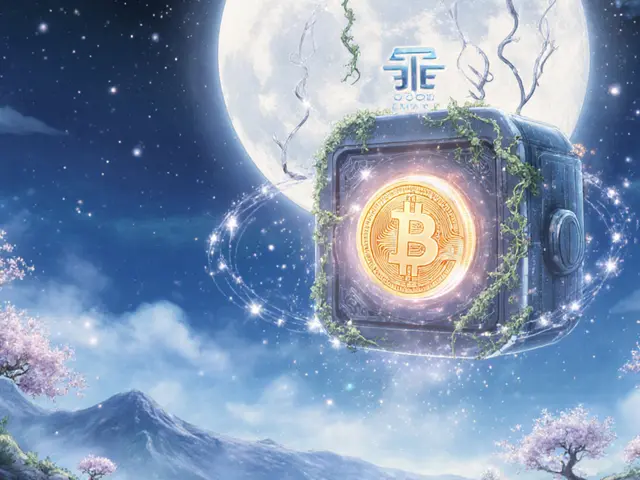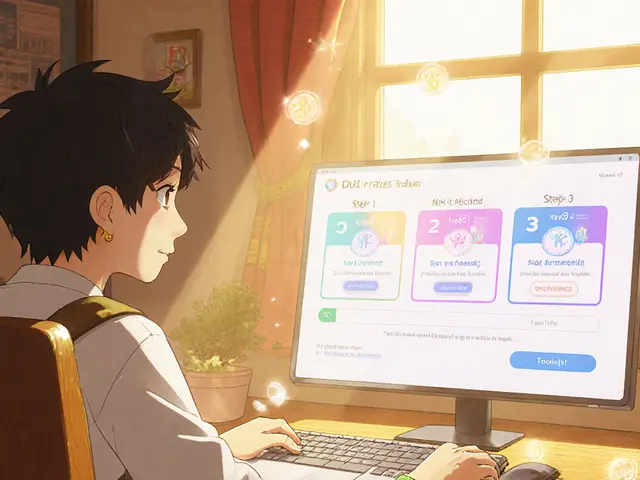11
What Are Public and Private Keys in Cryptocurrency? A Simple Guide to Digital Ownership

Imagine you own a safe deposit box in a bank. The bank gives you a key to open it - that’s your private key. Anyone can see the box’s number on the wall - that’s your public key a publicly shareable address used to receive cryptocurrency. If someone steals your key, they can empty the box. If you lose it, the bank won’t help you. That’s cryptocurrency in a nutshell.
How Public and Private Keys Work Together
Every cryptocurrency wallet starts with a pair of keys: one public, one private. They’re mathematically linked, but not the same. The private key is a long, random string of letters and numbers - something like5Kb8kLf9zgWQnogidDA76MzPL6TsZZY36hWXMssSzNydYXYB9KF. From that, your public key is generated using a one-way mathematical function called elliptic curve cryptography. It’s like baking a cake: you can’t turn the cake back into flour and eggs. Once the public key is made, you can’t reverse-engineer the private key from it. That’s what keeps your money safe.
Your public key gets shortened into what you see as your wallet address - something like 0x742d35Cc6634C0532925a3b844Bc454e4438f44e. This is what you give people when you want to get paid in Bitcoin, Ethereum, or any other crypto. You can share it on social media, email it, print it on a sticker. No one can steal your money just by knowing your public key. It’s like giving out your mailbox address. People can drop letters in, but they can’t open it.
The Private Key Is Your Identity
Your private key is the only thing that lets you spend your crypto. When you send money, your wallet uses your private key to create a digital signature. This signature proves you own the funds without ever showing the key itself. The network checks that signature using your public key. If it matches, the transaction goes through. No one else can make that signature. Not even the developers of the app you’re using. This is why people say, “Not your keys, not your crypto.” If you keep your crypto on an exchange like Coinbase or Binance, they hold the private keys. You can trade, but you don’t truly own it. If the exchange gets hacked or shuts down, you could lose everything. With your own private key, you’re in control. No middleman. No freeze orders. No bank holidays.What Happens If You Lose Your Private Key?
Losing your private key means losing your crypto - permanently. There’s no “forgot password?” button. No customer support team that can reset it. The blockchain doesn’t care who you are. It only cares if the signature matches the public key. If you don’t have the private key, you can’t sign. And without a signature, the network ignores you. Millions of dollars in Bitcoin are already locked away because people lost their keys. Some were forgotten on old hard drives. Others were typed into the wrong app. One guy threw away a hard drive with 7,000 BTC - worth over $400 million today. He didn’t know what he had. Thousands more have done the same.Public Keys Are Safe to Share - But Not Always
You can safely give out your public key. But here’s a twist: if someone knows your public key, they can see every transaction you’ve ever made. All your incoming and outgoing payments are on the blockchain, public for anyone to see. So while they can’t steal your money, they can track your spending habits. That’s why some users generate a new public key for every transaction. It’s called address reuse avoidance, and it helps protect your privacy. Some wallets do this automatically. Others make you manage it manually. If you’re using a simple app like MetaMask or Trust Wallet, you might not even notice. But if you’re holding large amounts, you should learn how to manage multiple addresses.
Seed Phrases: Your Backup Plan
Most wallets don’t make you write down your private key. Instead, they give you a 12- or 24-word recovery phrase - also called a seed phrase. This phrase can regenerate all your private keys. So if you lose your phone or your wallet app crashes, you can plug the phrase into a new app and get everything back. But here’s the catch: that seed phrase is your private key. It’s just written in human-readable words. If someone steals it, they can drain your wallet. That’s why you should never store it on your phone, email, or cloud drive. Write it on paper. Keep it in a fireproof safe. Don’t take a photo. Don’t type it into a note app. If you do, you’ve already lost control.Hardware Wallets: The Gold Standard
For serious users, hardware wallets like Ledger or Trezor are the best option. These are small USB devices that store your private keys offline. Even if your computer gets infected with malware, the keys never leave the device. To send crypto, you plug it in, press a button, and confirm the transaction on its screen. No typing. No exposure. They cost between $50 and $150. That’s cheap insurance if you hold more than a few thousand dollars in crypto. And unlike software wallets, they don’t rely on your phone’s security. If your phone dies, the hardware wallet still works. You just need your seed phrase.Why This System Matters
Public and private keys aren’t just a technical detail. They’re the reason cryptocurrency exists. Before this, digital money needed banks, payment processors, or governments to verify transactions. Now, math does it. No permission needed. No central authority. Just code, cryptography, and control. This system gives you real financial sovereignty. You can send money across borders in minutes, without waiting for banks or paying high fees. You can hold your wealth without fearing inflation or asset freezes. But with that power comes responsibility. You’re the bank now. And banks don’t refund mistakes.
Common Mistakes New Users Make
- Sharing your seed phrase with “support agents” - there are no real support agents. If someone asks for it, they’re a scammer. - Storing keys on cloud services - Google Drive, iCloud, Dropbox - all can be hacked. - Using the same wallet for trading and long-term holding - keep your savings in a hardware wallet, use a simple app for daily spending. - Assuming recovery phrases are foolproof - if you write it down wrong, you’ll never get your money back. Always test the phrase on a new device before trusting it. - Ignoring transaction fees - signing a transaction costs gas. If you don’t have enough crypto to cover it, the transaction fails. Always leave a small buffer.What’s Next for Public and Private Keys?
The core math hasn’t changed since Bitcoin launched in 2009. But the tools are getting better. Multi-signature wallets now require two or more private keys to approve a transaction - great for couples, businesses, or heirs. Wallets are starting to support biometric logins (fingerprint, face ID) - but they still store the keys securely, never in the cloud. Quantum computing is a future threat. In theory, powerful quantum machines could break elliptic curve cryptography. But that’s still years, maybe decades away. Experts are already working on quantum-resistant algorithms. For now, your keys are safe.Final Thought: Control Comes With Responsibility
Public keys let you receive. Private keys let you own. Together, they’re the foundation of true digital ownership. You don’t need a bank. You don’t need a password reset. You just need to keep your private key safe. If you’re new to crypto, start small. Use a trusted wallet. Write down your seed phrase. Store it somewhere safe. Don’t rush. Learn. Test. Then hold. Because in crypto, the only thing more powerful than the blockchain is your own discipline.Can someone steal my crypto if they know my public key?
No. Your public key is like your bank account number - it lets people send money to you, but they can’t take anything out. Only the private key can authorize transactions. If someone has your public key, they can see your balance and transaction history, but they can’t move your funds.
What happens if I lose my private key?
You permanently lose access to your cryptocurrency. There is no recovery option. No customer service, no reset button, no backup from the blockchain. The funds remain on the network, but they’re locked forever. This is why writing down your seed phrase correctly and storing it securely is non-negotiable.
Is my wallet address the same as my public key?
Almost, but not exactly. Your wallet address is a shortened, encoded version of your public key - designed to be easier to copy and paste. Think of it like a nickname for your public key. When you send crypto, you’re using the address, but the network still verifies it using the full public key behind the scenes.
Why do I need a seed phrase if I already have a private key?
Your seed phrase is a human-readable backup that can regenerate all your private keys - not just one. Most wallets create multiple addresses for privacy and convenience. The seed phrase gives you access to all of them. If you only had one private key, you’d need to back up every single address separately. The seed phrase makes recovery simple and complete.
Can I use the same private key for Bitcoin and Ethereum?
Technically, yes - because both use the same elliptic curve cryptography. But you shouldn’t. Each cryptocurrency has its own wallet format and address structure. Using the same key across chains increases risk. If one wallet gets compromised, all your assets could be exposed. Always use separate wallets for different coins unless you fully understand the risks.
Are hardware wallets completely safe?
They’re the safest option available, but not 100% foolproof. If someone physically steals your device and knows your PIN, they can access your funds. If you enter your seed phrase into a fake app that looks like the official one, you’re still at risk. Hardware wallets protect against remote hacking - not social engineering or physical theft. Always verify the device’s authenticity and never share your PIN or seed phrase.










